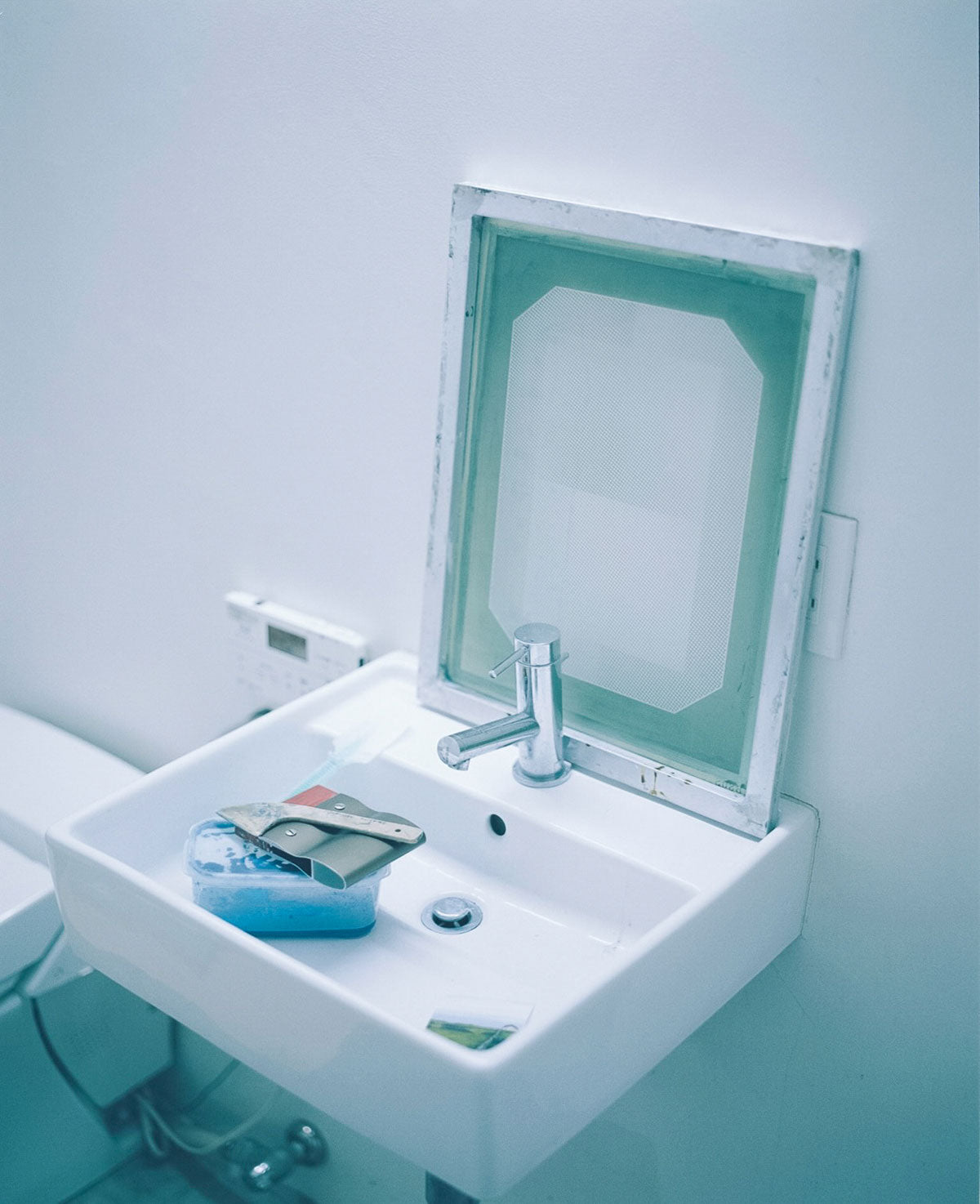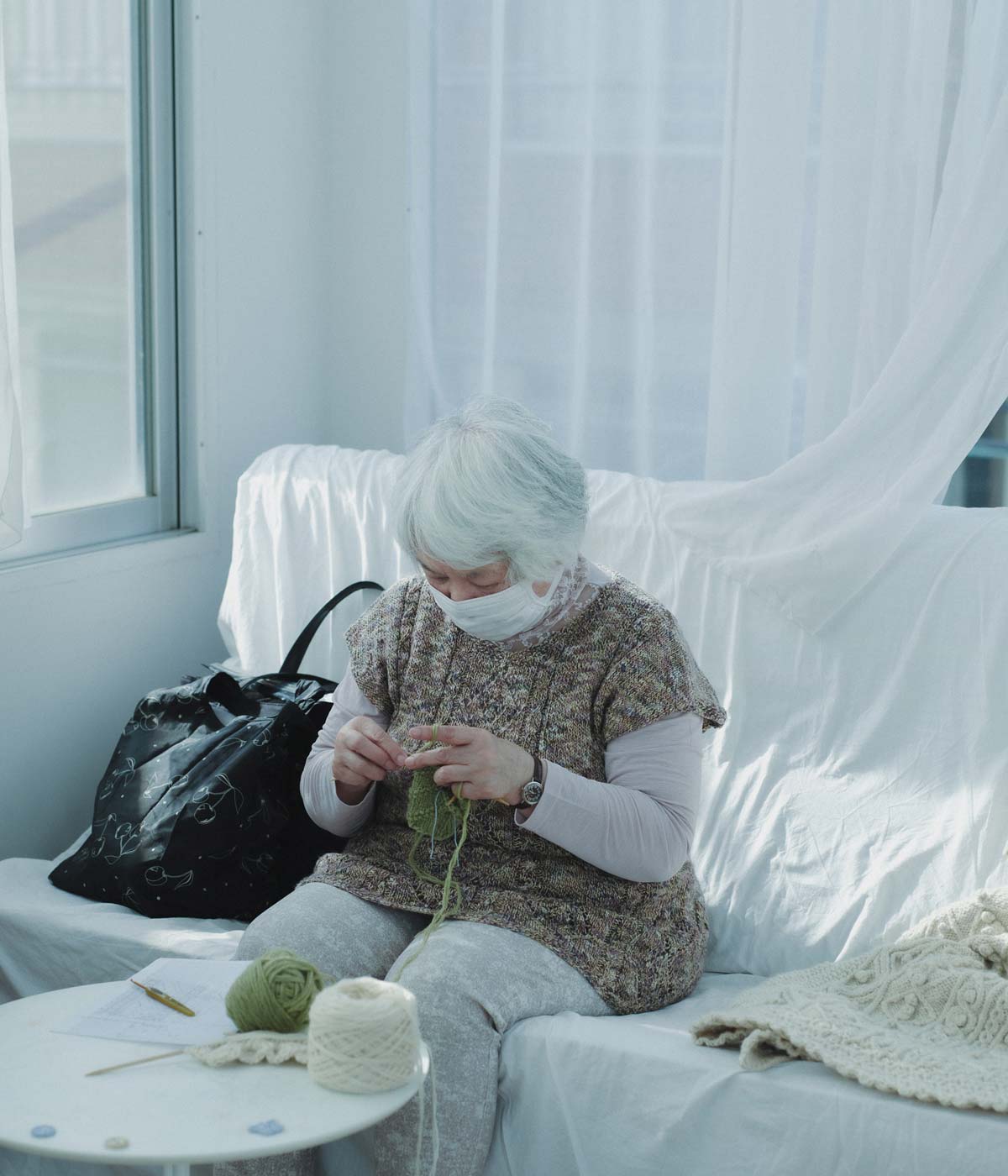"New seeds" Knitting memories Sweater production diary (8)
STORY | 2023/04/30

A strong wind was blowing, like a storm. The sky was clear, but the spring breeze blew in, and the cherry blossom petals flew from somewhere, even though they should have already been scattered.
From April 8th , YUKIFUJISAWA 's new Aran sweater unveiling party was held. When I visited the venue "Moriyama Matei Aito / Eito", the sweaters that had just been made were displayed.

Before the unveiling party started, models Mika and Ume wore the new sweaters and Mr. Wahei Kimura took pictures. Depending on the location, the amount of light changes greatly, and the expression of the thread changes slightly. I fell in love with the color for a while.
Aran knit's classic " WHITE " is a shade that makes the most of the color of wool. This "WHITE" and " NAVY " which makes you feel the texture of indigo dyeing. Apart from that, there are two new colors. One is " GREEN ", which was inspired by the grass and earth of the Aran Islands. The other is “ PINK ,” which has a subdued flavor created with the motif of flowers that Yuki-san saw in the Aran Islands.

Three new sweaters were knitted this year. The first is " Inis Mór ". It is a pullover sweater bearing the name of the island. It was inspired by a sweater with different patterns on the front and back that I saw at the National Museum of Ireland.
A geometric pattern that makes you feel like an aran knit and a pattern that reminds you of flowers blooming on an island overlap. What is impressive is the rough neckline. He told me that the origin of this shape was a sweater that Yuki's father had bought in Europe over 30 years ago and passed on to Yuki.

The second is a cardigan called " Dublin ". A plain knitted sweater reminiscent of the Gandhi sweater, the origin of Aran knit.
Since the Gandhi sweater is a fisherman's sweater, many of them had a simple design so that they could be easily repaired if they got frayed. Inspired by Fisherman's sweaters, the " Dublin " has a design on the sleeves and hem, and you can choose the pattern of the pockets.


The third, “ Galway ,” is a cardigan that perfectly fits the word gorgeous. Chiyoko, a knitter, deciphered the knitting pattern of Aran knit, and it took 200 hours to knit each piece. If you are knitting a plain knit, it is possible to knit it without spending so much time, but Aran knit is tightly packed with patterns. Like the Gandhi sweater, the Aran knit was also knitted as a fisherman's sweater.
This " Galway " is also a piece that lets you experience that history. As the pattern is tightly packed, it feels solid and solid, and it seems that it will protect you from the strong beach breeze.


If you take a closer look at the venue, you will find that not only new knitwear but also various other items are quietly arranged. Flowers are lined up here and there. As I wondered what kind of flower this was, Yuki-san told me, "The person who prepared this flower was ' Mana-chan ,' whom I talked about in the previous diary." At the venue, the artist Mana Yamamoto, also known as “ Mana-chan, ” told me that the one I was looking at was named Lace Flower. It is said that the flowers on display were selected based on the image of the scenery of Aran Island and Yuki's knitwear.
"The flowers in the basement are wonderful." Guided by Mr. Moriyama, I went down to the basement of "Aito". The basement of "Aito" is a bathroom, with a bathtub and a shower head. As if snuggling up to the bathtub, the flowers were lined up as if they had grown from there. The floor is concrete, but you can smell the earth. The flower that looks like pure white lace is "Orrea grandiflora".

The documentary film "Alain" was projected on the wall of the bathroom. Mr. Moriyama told me that the film directed by Robert J. Flaherty, known as the father of feature-length documentaries, was released in 1934 . 1934 is the time when the Aran Sweater was born. Nearly 100 years later, in Tokyo, far beyond the sea, a new Aran sweater was born.
In the image projected on the wall, a ship is floating in the desolate sea. Orrea grandiflora is swaying like a silhouette at the end of the image. Yuki's new work is spun after traveling a tremendous amount of time and distance from Aran Island recorded on video.
"I was thinking of filling the bathtub with water and floating a boat there, but I couldn't find a boat that could float here." Mr. Moriyama says regretfully. Instead of filling the bathtub with water, three photographs were placed in it. The small flowers blooming on the road, the horses standing behind the stone wall, the sea seen from the window of the liner—the sights that Yuki-san saw on Arran Island are lined up at the bottom of the bathtub. A nearby washbasin had a silkscreen frame that Yuki uses in her atelier and a squeegee for spreading the ink.

A ticket for visiting Aran Island and a note written there. On the shelf are the knitted accessories that I have presented so far, the yarn that I will use for my new work, and the letter I received from Chiyoko while making samples. The bottles that Yuki-san bought when she traveled to Europe are also lined up, and the flowers arranged there are also lined up. It seems that the time Yuki has spent so far is crystallized and scattered.

The weather is nice, so I take a walk around the neighborhood. At a small intersection, an elderly man was standing with a red bucket and a brush in his hand, finding dirt on the road and washing it off. There are many old houses in the neighborhood, but they are well cleaned. Each house has a different shape and different roof color, but every house has a clothesline and the laundry is swaying in the wind. And there are plants and potted plants everywhere, and colorful flowers are in full bloom.
People try to add color by incorporating flowers and greenery into their lives. Yuki's sweater will also add color to someone's life.

At the venue, buttons in various colors were placed in a hidden way. Customers who order cardigans are searching like treasure hunts to find their favorite buttons. Chiyoko, a knitter, was also on the 3rd floor of Eito, which has a particularly large window.
When it comes to knitwear on the shelves of stores, we don't know who will buy it, but when we knit to order, the recipient is already decided. Among the new sweaters, there is also a cardigan that takes 200 hours to knit. Chiyoko told me that she came to the unveiling party because she wanted to get a sense of what kind of people would wear the cardigan that she put so much time into knitting. Chiyoko was knitting a knit in the space where customers were trying on sweaters, illuminated by the light shining through the window.

While the unveiling party was being held, the door was left open. As I gazed at the open door, I remembered a poem. Mieko Kawakami's "Treatment, the name of the house is cosmos". In 2018 , when Mieko Kawakami's poem was staged by the theater company Mum and Gypsy, Yuki was in charge of the costumes for "Treatment, the name of the house is cosmos." The poem begins like this:

On this day, it was reported that not only was a stormy wind blowing, but yellow sand was also flying from the continent. If you leave windows and doors open, you run the risk of something bad coming in from the outside. However, Cosmos, who had "always tightly closed the windows and doors of the small house", opens the door at the end.
( … ) After that, I curled up in bed for about three hours, then pretended not to see the pain that had been pushed deep inside me. I took it off. It all just happened. There were many lids. The same number of entrances and exits. I opened the cupboard, pulled out the file case, lifted the glue lid, and opened the refrigerator door. Then he walked slowly to the window and pushed open the one he hadn't touched in years. I opened the front door as wide as I could. The wind blew in a straight line through them, and it was like a gigantic tube running through them. Cosmos seemed to collapse under the force. But it reminded me of something Cosmos knew all too well, something very, simply, reproachful.
(Mieko Kawakami "Therapy, the name of the house is cosmos")

The people who came to the unveiling party must have opened the front door to meet something new. Or maybe the people who participate in the online order fair also opened the window in the hope that something new would come in.
When I looked into the kitchen, it was decorated with small flowers. As I gazed at the flower, Ms. Mana told me that it was a microrose called "Little Woods." The flower was displayed when Ms. Mana exhibited here. After the exhibition is over, Mr. Moriyama takes cuttings to increase the number of flowers and decorates them here and there. “Moriyama-san is good at rooting,” said Mana-san.
The sweater ordered at the unveiling party is carefully woven over a long period of time, and eventually becomes a sweater and is transported to someone's house. It will become an irreplaceable piece of clothing that will take root in your life and spend a long time together.

WordsRinshi Hashimoto
Photo Kazuhei Kimura